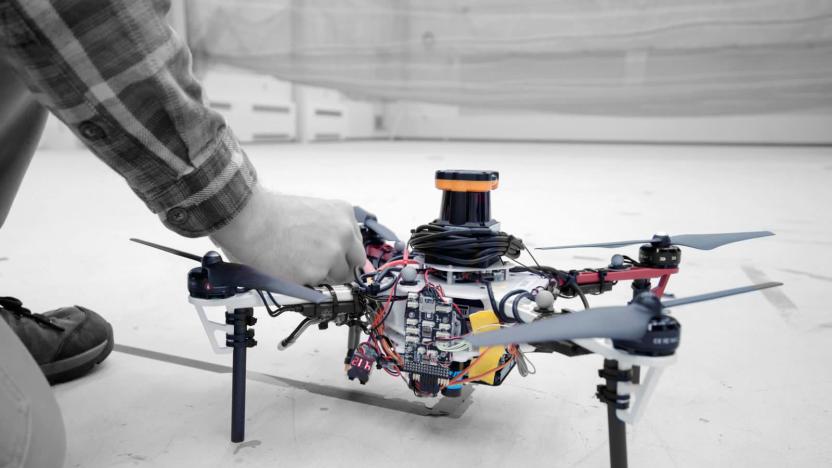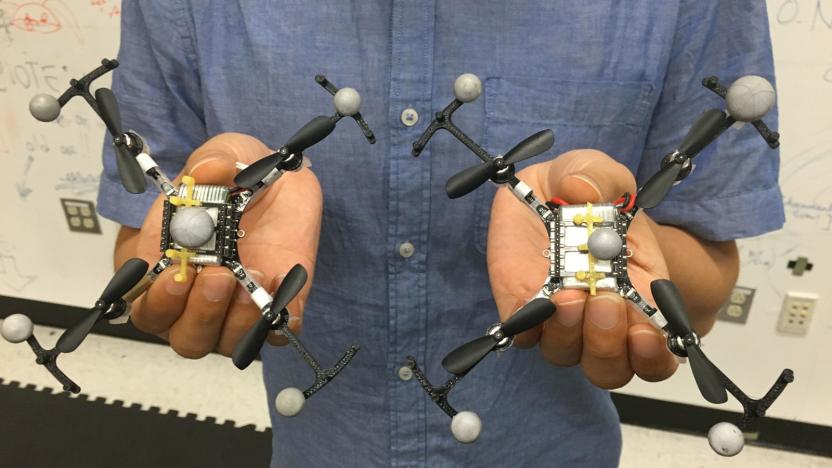droneswarm
Latest

Drone fleets could find lost hikers in forests without using GPS
Drones can already be effective search and rescue tools, but not in densely-packed forests where the tree cover might block GPS signals. Thankfully, MIT has a clever solution: use the same technology that guides self-driving cars. Its researchers have developed drone tech that uses LIDAR to map forests without any use of GPS. Each drone creates a 2D map that also includes the orientations of trees, making it easy to tell where the robotic aircraft has already been as it searches through a specified area. That, in turn, makes it feasible to merge maps from an entire drone fleet and comb large swaths of forest with a minimum of wasted effort.

Criminals used a drone swarm to disrupt an FBI hostage rescue
Drones are what you make of them. One person's wedding videographer is another person's drug mule. And while hobbyist drones were first used for simple jobs like sneaking contraband into prisons, over the years they've become the criminal's Swiss Army knife of gizmos. The FBI's Joe Mazel told a crowd at the AUVSI Xponential conference this week about a particularly organized gang that used drones to interfere with a hostage situation last winter. As Defense One reports, a swarm of small drones descended on an FBI hostage team, performing "high-speed low passes" in an effort "to flush them" from their position. "We were then blind," Mazel added.

Virtual 'top hats' ensure swarming drones won't crash
Drone swarms can be used for lots of things, like creating holograms, putting on a Superbowl halftime show or collecting military intelligence. One of the problems with a bunch of quadcopters executing maneuvers in close proximity, however, is that they can crash when they touch or fly under each other. Researchers at the Georgia Institute of Technology have found a way to avoid both issues by creating a virtual bumper area around each copter so that they don't accidentally touch. They've also ensured that each copter has a little "top hat" of space above it so it won't go underneath another drone and get caught up in its airflow.

Position tracking protects drone herds against hackers
Much ado has been made over flying drones in groups, but there hasn't been much thought given to protecting autonomous drone groups against security breaches. What happens if someone impersonates enough drones to hijack their collective decision-making process? MIT might have a viable defense. Its researchers have developed a positioning technique that would prevent and mitigate these kind of impostor attacks. The key is to give each drone a wireless fingerprint that reflects its interaction with the environment -- effectively, the network can tell the difference between the actual drone pack and a fraud operating from the outside.

Lady Gaga's Super Bowl show will tout 'hundreds' of drones
It's easy to be cynical about the Super Bowl's halftime show: unless you're a fan of the artists, it's often an excuse for a bathroom break... or at least, to gawk at the ridiculousness of the American cultural zeitgeist. Lady Gaga might give even the jaded a reason to tune in this year, though. CNN sources hear that the "Bad Romance" singer (who's rather fond of tech) is planning a show using "hundreds" of lit-up drones, marking the first time that robotic fliers have graced the Big Game. Gaga and crew aren't spoiling the show, but people in the Houston area have witnessed drones swarming over the football stadium like a horde of glitzy UFOs.

Intel's latest light show was the first FAA-approved drone swarm
The Association for Unmanned Vehicle Systems International (AUVSI) is hosting its annual event in New Orleans this week, and as part of the festivities, FAA administrator Michael Huerta made a few key announcements. First, Huerta revealed that the agency would relax regulations on who can fly drones. Students and instructors will no longer need a Section 333 exemption or other authorization to fly a UAV for "educational and research purposes." As long those eager learners have to do is abide by the guidelines for using model aircraft, they'll be in the clear.



